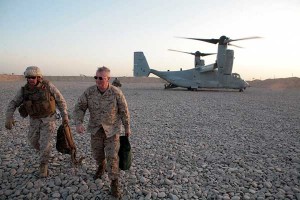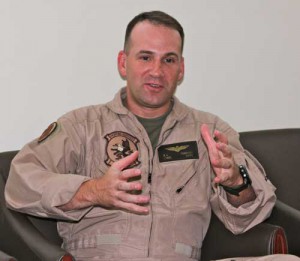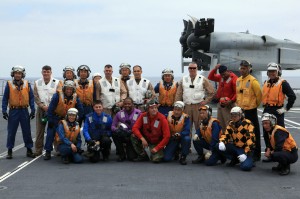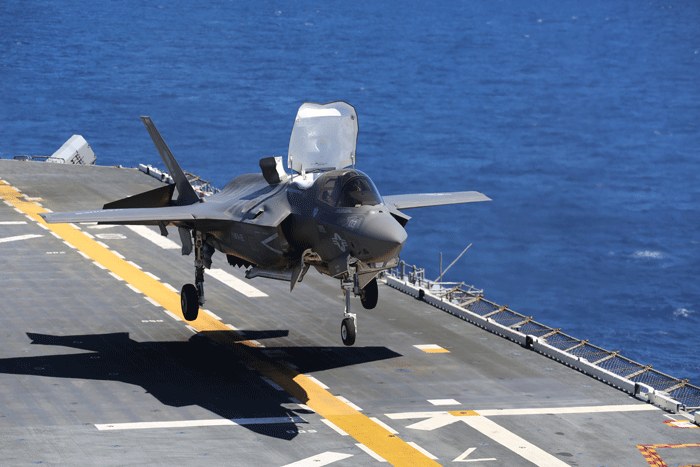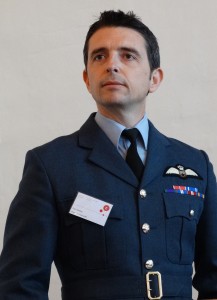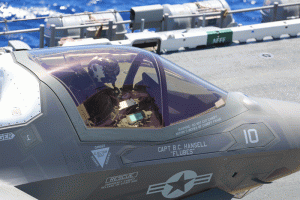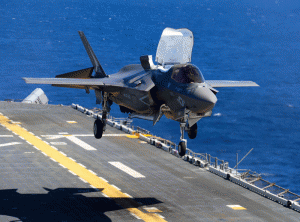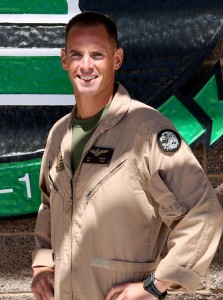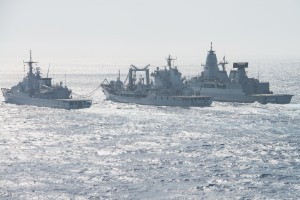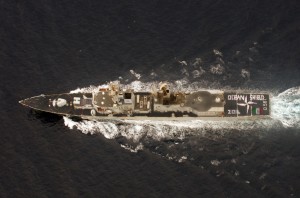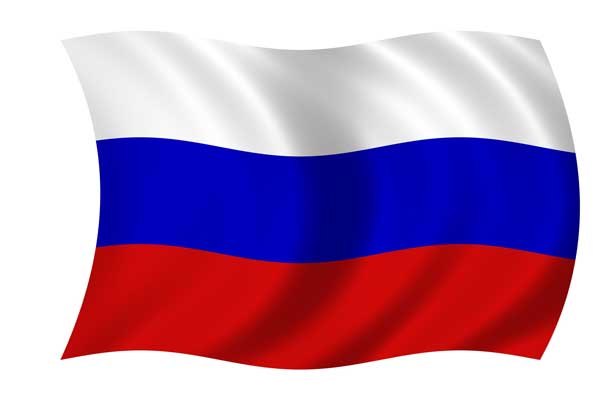2015-06-12 By Robbin Laird and Murielle Delaporte
Marine Air Group 31 is located at MCAS Beaufort, South Carolina.
It is the home of six F-18 squadrons and one F-35 squadron.
The F-35 Squadron – VMFAT-501 – is training coalition and USMC F-35B pilots to operate the F-35B.
When Second Line of Defense last saw the Warlords, they were located at Eglin AFB, but moved to Beaufort last year.
When we last met with the Warlords in Eglin, Lt. Col. Berke was the CO and now Lt. Col. Bachmann, whom I interviewed after he did the 200th sortie of the F-35B in 2012.
At the time, the F-35B had about 800 flight hours; now it has more than 12,300 mishap free flight hours as of June 2015.
The visit at Beaufort was a week prior to going to the USS WASP to view F-35B ship integration operational testing as well and of the six planes aboard the WASP, two came from Beaufort and four from Yuma.
The Yuma planes had come first to Beaufort and then flew onboard the WASP with the Beaufort squadron planes.
The visit highlighted that the Marines are already working integration with the legacy fleet; the Beaufort squadron flies regularly with the F-18 pilots; and also with the USAF, notably with regard to the Georgia Air National Guard in the Savannah Sentry exercise.
The interviews at MAG-31 started with the CO of the squadron, Col. William Lieblein, who assumed command of MAG-31 on 20 May 2013.
He is an F-18 pilot by trade and learned to fly the F-35 earlier this year.
“My most recent training was to learn to fly the F-35. That was exciting and really allowed me to understand how complex the aircraft is and the capabilities of the aircraft and the future potential of the aircraft within the MAGTF.
We have six F-18 squadrons here. We’ll start transitioning those squadrons somewhere around 2018, but the Marine corps is going to fly the F-18 through 2030 and so the integration of that fourth generation platform and the continued development of the F-18 to be a relevant platform through our final transition to sundown in the aircraft at 2030 is significant.
How we integrate that platform as it evolves with the F-35, our fifth generation, for MAGTF aviation is significant.
We’ve already started that right now as they are participating in local training.
We send out F-18 squadrons to fly with our F-35s.
They are training with us on a daily basis.”
Col. Lieblein highlighted the fact that the work on integrating the 4th with 5th generation aircraft was part of the transition and part of what was becoming the normal routine at MAG-31.
“I see one of our primary tasks here at MAG31 because we have the F-35 squadron here with F-18 squadrons is to develop the integration between the fourth and fifth gen and how we are going to do that.
MAWTS-1 is currently working that right now with that WTI course.
They’re already doing that with F-22’s and they will do it with F-35’s in this next course.
We’re already doing it here with F-35’s.”
The Colonel then noted that they are working with the South Carolina and Georgia National Air Guards as well on fourth and fifth generation exercises.
He added that other efforts were being made, for example, flying with F-22s as well as Tornados (which came from the UK), which were operating from Shaw Air Force Base in South Carolina as well.
The conversation was joined with Major Brian Bann who is with the F-35 Squadron and was previously with the squadron when it was located at Eglin.
He has been with the Warlords for almost three years. Maj. Brian Bann became the eighty-first pilot to fly the F-35 when he took off for his first flight in the Lightning II from Eglin AFB, Florida, on 8 April 2013.
“We flew our F-35s with F-22’s, F-15C’s, F-15E’s, F-16CJ’s, T-38’s, F-5’s, and F18s during the Savannah Sentry exercise.”
Col. Lieblein underscored that: “When you go from the F-18 to the F-35 it is a very different experience.
The problem is that if you bring your F-18 tactics with you will miss the point.
That will not optimize the platform.
Through our operational testing we will optimize specific tactics with regard to the aircraft. It is being worked through operational experimentation.”
Of course, for the Marines, the point of fighter integration is to support the MAGTF and the Marines on the ground.
Col. Lieblein hammered home the point that “it is not just fighter to fighter but support to the Marine on the ground and integration with the MAGTF.
We are working on close air support and figuring how best to do that with the F-35 and we are working with MARSOC as well to look at how best to support their operations.”
The CAS question naturally raises the question about the future of planes like the A-10 compared to an F-35.
For Col. Lieblein: The A-10 was great for yesterday’s war and some of the situations today, but the F-35 is good for yesterday’s, today’s, and tomorrow’s war.
It doesn’t matter where that ground guy is and what type of threat he’s facing, the F-35 will support him.”
And with the evolution of warfare, the Marines have to be prepared for things like cyber threats as well.
And the Colonel added that “When we go to war, we are need integrated capabilities, and the F-35 provides a substantial way forward with regard to integration of capabilities within a platform.”
Major Bann added: “the airplane’s absolutely an information gatherer.
It sees everything out in the battlefield, IADS, lay-downs, air pictures.
It’s like an AWACS/river joint almost combined.
The great thing is now it transmits it all over Link 16, so it’s pushing all that information to not only US folks, but also our coalition partners and to ground partners as well.
There is an incredible amount of situational awareness with that airplane when you fly.
The cockpit fusion paints a pretty good picture for you in the airplane.
You don’t have to do a lot of thinking about what’s going on.
It describes it for you there.
There’s complete sharing of information between us (F-35s) as we are flying together, but how do we optimize that with other aircraft to shape the most effective operations.”
When asked how he would describe the transition from when he first joined the Warlords until now, Major Bann made it clear that progress has been significant.
“It’s been a great transformation.
We started out with 1B airplanes with very limited software capabilities, but every month, basically, we get more enhanced capabilities of software with radar, EW, flight characteristics, so now we’re doing solo all the time.
We just sent six airplanes to the USS WASP yesterday, which will be at sea.
It’s been an amazing transformation from flying basically solo down to Eglin about three years ago and just doing basic task sets to now flying large force exercises here with F-22s, F-16s, F-18s, and full integrations with our F-35s here.
We’re getting a new one basically every month; the newest airplanes off the ramp at Lockheed-Martin and it is an absolute pleasure to watch the airplane go from where it has been to where it is now.
We’re learning things every day.
We’re finding that this airplane is incredibly easy to fly compared to the Harrier. We are not going to have a massive training time to fly aboard the LHAs and LHDs, and we will not have to focus on the challenges of taking off and landing but focus on the mission as our primary task.”
The final subject was with regard to mission flexibility and the impact of the F-35.
Does the flexibility of the aircraft affect the way you would plan a mission with this flexibility in mind?
Col. Lieblein answered that, “That is a good question.
I think it is definitely going to change the way we plan a mission because the aircraft is so much more complex and so much more capable, we have to be prepared to do anything within its capability.
Because of the fusion of the sensors, it’s going to be easier to switch from mission to mission.
It will take a lot more work up front to plan for it, but you will be able to switch between missions more easily in the aircraft because of the fusion of the sensors and the weapons systems aboard the aircraft.”
After the discussion with Col. Lieblein and Major Bann we moved to a meeting with Lt. Col. Bachmann, the CO of the Warlords.
In an article by Jeff Rhodes published on May 23, 2015, the view of Bachmann with regard to the transition was highlighted:
“We opened here on 7 July 2014,” said Bachmann, who served as an F-35 test pilot early in the program’s history. “It was an interesting transition.”
Normally when a squadron moves, it shuts down operations at the old base and sets up shop at the new base. “But we didn’t do that,” said Bachmann. “We were flying twice a day at Eglin. We were training pilots. We had to keep the flying schedule up, at least at first. The Marine Corps told me what I had to do, but not how to do it.”
Squadron personnel started moving to Beaufort in June 2014. All the squadron maintenance moved together, and the aircraft stayed at Eglin. Operations ramped down in Florida and nearly simultaneously started ramping up in South Carolina.
There were issues, but overall, the transition went well. Bachmann flew the first F-35B to Beaufort on 18 July 2014. The first flight supported entirely by Marine maintenance came on 4 September. The first F-35B belonging to the United Kingdom, which was also the last aircraft to be transferred from Eglin, arrived on 6 February 2015. An instructor pilot made the first night flight from Beaufort on 6 March.
“My job is to produce the amount of pilots the Marine Corps tells me and to produce the kind of pilots the Marine Corps wants,” said Bachmann. “The communications between us and the operational community is fantastic. I trained the IPs at the other bases and we talk almost every day. My tactics instructors are talking to their tactics guys to make sure we are all on the same page.”
A natural question to start with the CO was simply to go back to the last meeting and talk about the progress since that 200th sortie flight.
After the flight, Bachmann provided the following perspective on the plane and the progress as of the Fall of 2012:
Question: You have been with the program for a while.
Bachmann: Yes I have. I have been with the program since 2006. And I have been here at Elgin for two and half years. Prior to that I have been a Harrier pilot and have done a stint as a forward air controller.
Question: How would describe the current learning process at Eglin with regard to the plane? Bachmann: I would emphasize the role of the maintenance officers. These guys are on the cusp of getting their MOSs or Military Occupational Skills. Their jobs as avionics, or engine or power line maintainers mean’s they have gone to skill and are getting certified.
They have got airplanes to work on, and are getting ready to go to Yuma and stand up the first squadron there. Their ability to go to school, work on the airplanes, fix them when they come back from flights, and then we fly them again is absolutely fantastic for the program.
The maintainer cadre is what will cause the F-35B to succeed in the USMC. It is wickedly important.
The new Yuma squadron cannot survive without its core maintainers and it is really important that we get the training right.
Question: What about the stability of the aircraft?
Bachmann: The plane is a very stable platform to fly. And over time is becoming more and more predictable; the software from this point of view is mature.
And the other combat systems are already impressive. The pilots are already commenting that the combat systems are light years ahead of what legacy does.
Question: “Dog” Davis made the comment that one of his pilots was flying from Fort Worth to Eglin and was accompanied by two F-18s. He told me that the pilot asked the F-18s could see the “clean” F-16 meeting them from Eglin a significant distance ahead. Does that square with your experience?
Bachmann: Actually I was the pilot that General Davis was talking about.
Even in its relatively immature state, the combat systems are superior to legacy systems.
Fast-forward to May 2015, and “OD” Bachmann highlighted the progress in the following way:
Coming to Beaufort has been crucial to moving the ball forward with regard to IOC.
We have been able to operate the aircraft with Marine Corps maintainers and to integrate the plane into our approach to maintenance and operations.
The readiness of our airplanes to fly on the ramp increased by almost 30% the day we fully go here at Beaufort.
Being on an all-Marine base has increased our readiness.”
Clearly, as the plane is maturing and so are the pilots flying the aircraft.
Literally, we have produced twice as capable of an F-35 pilot as we used to because of the capabilities of the airplane have increased.
Before, we were just teaching simple takeoff and land, navigate, a flight formation, maybe some small tactical pieces, or slices of the airplane because of what it can perform to a much higher capable pilot.
And the fact that not only can he fly day and night, he can fly in the clouds, and he can do tactical missions to include close-air support, armed reckie tactical intercepts with multiple airplanes, and operate multiple airplanes in the same data link.
That, to me, is obviously where the airplane needs to be, but now we’re teaching that here at the school.
With regard to the transition it is a challenge because pilots from the various legacy backgrounds are being trained and then the newbies are coming next.
We have to prepare for the future, but we also still have to execute today.
I’ve got three classes on board, and each class is doing something slightly different.
And that’s my workflow, it’s not only is it right now,
it’s the next four months, and next year that we’re planning for.
We will have our first Prowler pilots training here in August and next year we will teach pilots who come out of training and this will be their first fighter ever.
The pilots will be coming straight from T-45s to the F-35.
Colonel Lieblein Bio
Colonel Bill “Beavis” Lieblein was born in Jackson, Michigan in 1965. He graduated from GMI Engineering & Management Institute in 1988 with a degree in Industrial Engineering. He underwent flight training in Corpus Christi, Texas; Kingsville, Texas; and Jacksonville, FL.
1st Lieutenant Lieblein reported to VMFA-451 at MCAS Beaufort, SC in August, 1993. While assigned to VMFA-451, he served as the Intelligence Officer, CMCC Officer and Schedules Officer. He made one Western Pacific deployment with the Warlords.
Captain Lieblein reported to 3rd Battalion 6th Marines at Camp Lejeune, NC in June 1995 as a Forward Air Controller, and made one Western Pacific deployment with the battalion. Captain Lieblein reported to VMFA-251 at MCAS Beaufort, SC in June 1996 as the Pilot Training Officer. While assigned to the Thunderbolts, he attended the Weapons and Tactics Instructor Course and Marine Division Tactics Course. He made one deployment with the Thunderbolts and Carrier Air Group One aboard the USS George Washington to the Persian Gulf in support of Operation Southern Watch.
Captain Lieblein reported to the Marine Aviation Weapons and Tactics Squadron One (MAWTS-1) at MCAS Yuma, AZ in January 1999. While at MAWTS-1, he served as the Schedules/CMCC Officer, F/A-18 Division Head and TacAir Dept Head.
In July 2002, Major Lieblein reported to US Army Command and General Staff College at Fort Leavenworth, KS. Upon graduation in June, 2003, he received orders to VMFA-122 at MCAS Beaufort, SC. He served as the Aircraft Maintenance Officer and Executive Officer, and made one Western Pacific deployment with the Crusaders. From July 2005 to June 2006, he served as the MAG-31 Training Officer Cell Section Head.
Lieutenant Colonel Lieblein assumed command of VMFA-122 in June 2006. While in command, the Crusaders made one Western Pacific deployment. He relinquished command in January 2008 and assumed the duties as the MAG-31 Safety Officer.
Lieutenant Colonel Lieblein reported to Special Operation Command at MacDill AFB, FL in July 2008 and served as the Global Force Management Branch Chief.
In July 2010, Colonel Lieblein reported to 2d Marine Division as the Air Officer at Camp Lejeune, NC and was subsequently assigned as the Fires and Effects Coordinator for 2d Marine Division (Forward). From February 2011 to March 2012, he deployed to Camp Leatherneck, Afghanistan in support of Operation Enduring Freedom.
In August 2012, Colonel Lieblein reported to Marine Forces Command at Norfolk, VA as an aviation officer. He assumed command of MAG-31 on 20 May 2013.
For a companion piece from the Beaufort visit, see the following:
For a look at the Wasp operational trials, see the following:
For a Special Report updating the preparation of the F-35 for its introduction into service, see the following:
The first slideshow highlights the visit to the Warlords.
- The first few shots show some of the F-35s at the squadron that day, including one with Wasp markings that was prepared to join OT-1.
- The sixth photo shows Squadron Leader Nichols in front of a UK F-35. Even though he is standing in front of the plane, within the squadron any squadron member might fly this plane, as will the Brits fly USMC jets. This is the same as at Luke where the Aussies and the USAF pilots fly each other’s planes. This is part of the F-35 global enterprise already being stood up.
- The seventh and eighth photos show Murielle Delaporte with Squadron Leader Nichols and Major Brian Bann.
- The final photos show Lt. Col. Bachmann and Major Bann with Murielle Delaporte and Robbin Laird in front of the Warlords squadron building.
Credit Photos: Second Line of Defense
The second slideshow highlights the engagement of the squadron with the USAF.
- In the first photo, an F-35B Lightning II from Marine Corps Air Station Beaufort, S.C., sits on the tarmac during Sentry Savannah 15-1.
- In the second photo, Airmen watch the arrival of 2 F-35B Lightning IIs from Marine Corps Air Station Beaufort during Sentry Savannah 15-1.
- In the third photo an F-16 from the 148th Fighter Wing, Duluth, Minn., takes off during Sentry Savannah 15-1.
- In the fourth photo, an F-16 from the 113th Fighter Wing, D.C. Air National Guard, takes off during Sentry Savannah 15-1
- In the fifth photo, a KC-135 from the 117th Air Refueling Wing, Alabama Air National Guard, taxis past a departing F-22 from Tyndall Air Force Base, Fla., during Sentry Savannah 15-1.
- In the sixth and seventh photos, F-22s from Tyndall Air Force Base, Fla., and F-16′s from the113th Fighter Wing, DC Air National Guard, sit on the flightline prior to operations during Sentry Savannah 15-1.
- In the final photo, a Marine Corps F-18 from Marine Corps Air Station Beaufort, S.C., takes off to support an air-to-air mission during Sentry Savannah.
Credit:Savannah Combat Readiness Training Center:2/17/15
Murielle Delaporte has a comprehensive look at the F-35 from the pilot’s perspective which appears in the Valeurs Actuelles special section on the Paris Air Show, which also includes comments by General Mercier, the Chief of Staff of the French Air Force and the next commander of the Allied Transformation Command on airpower transition.
Valeurs Actuelles is the largest circulation weekly in France.







